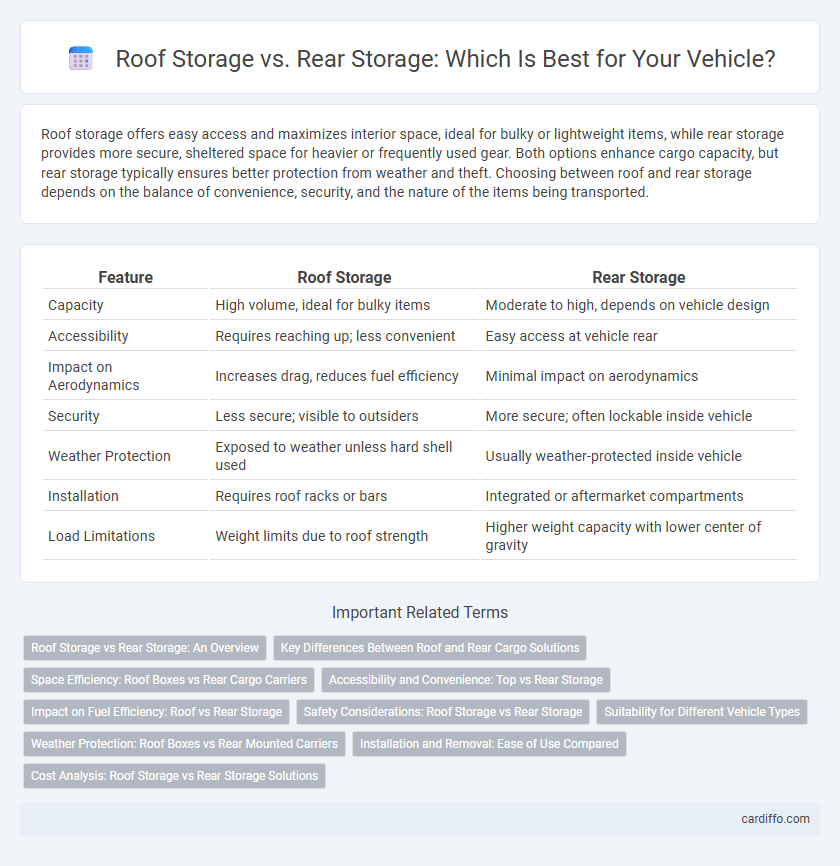Roof storage offers easy access and maximizes interior space, ideal for bulky or lightweight items, while rear storage provides more secure, sheltered space for heavier or frequently used gear. Both options enhance cargo capacity, but rear storage typically ensures better protection from weather and theft. Choosing between roof and rear storage depends on the balance of convenience, security, and the nature of the items being transported.
Table of Comparison
| Feature | Roof Storage | Rear Storage |
|---|---|---|
| Capacity | High volume, ideal for bulky items | Moderate to high, depends on vehicle design |
| Accessibility | Requires reaching up; less convenient | Easy access at vehicle rear |
| Impact on Aerodynamics | Increases drag, reduces fuel efficiency | Minimal impact on aerodynamics |
| Security | Less secure; visible to outsiders | More secure; often lockable inside vehicle |
| Weather Protection | Exposed to weather unless hard shell used | Usually weather-protected inside vehicle |
| Installation | Requires roof racks or bars | Integrated or aftermarket compartments |
| Load Limitations | Weight limits due to roof strength | Higher weight capacity with lower center of gravity |
Roof Storage vs Rear Storage: An Overview
Roof storage offers increased cargo capacity without reducing interior passenger space, making it ideal for transporting bulky items like skis or camping gear. Rear storage, often integrated within the vehicle's trunk or rear hatch, provides easier access and enhanced security for everyday items but may limit available passenger space. Choosing between roof and rear storage depends on balancing cargo volume, accessibility, and the type of gear being transported.
Key Differences Between Roof and Rear Cargo Solutions
Roof storage solutions offer increased cargo capacity without reducing interior space, ideal for bulky items like skis or camping gear, while rear storage provides easier access and better protection from weather elements. Roof racks typically impact vehicle aerodynamics and fuel efficiency more than rear cargo boxes, which remain low and compact. Rear storage options often integrate seamlessly with vehicle design, enhancing convenience for frequent loading and unloading compared to roof-mounted alternatives.
Space Efficiency: Roof Boxes vs Rear Cargo Carriers
Roof storage solutions offer increased vertical space, making them ideal for bulky or irregularly shaped items without compromising interior passenger room. Rear cargo carriers provide easier access and typically support heavier loads while maintaining better fuel efficiency compared to roof boxes. Choosing between roof boxes and rear carriers depends on balancing cargo volume, vehicle aerodynamics, and weight distribution for optimal space efficiency.
Accessibility and Convenience: Top vs Rear Storage
Top storage offers enhanced accessibility by allowing easy access to items without bending or reaching into cramped spaces, making it highly convenient for frequently used belongings. Rear storage compartments often require more effort to reach, especially in compact areas, which can limit quick access and reduce overall convenience. Choosing top storage maximizes user comfort and efficiency by providing clear visibility and simple retrieval of stored items.
Impact on Fuel Efficiency: Roof vs Rear Storage
Roof storage increases aerodynamic drag significantly, resulting in higher fuel consumption due to added wind resistance, especially at highway speeds. Rear storage, such as hitch-mounted cargo carriers, has less impact on fuel efficiency since it maintains the vehicle's streamlined profile more effectively. Choosing rear storage can improve fuel economy compared to roof-mounted options by reducing the increased air resistance that roof racks create.
Safety Considerations: Roof Storage vs Rear Storage
Roof storage increases the vehicle's center of gravity, potentially affecting stability and increasing the risk of rollovers, especially during sharp turns or sudden maneuvers. Rear storage maintains a lower center of gravity, preserving handling and braking performance while offering safer weight distribution. Properly securing items in both roof and rear storage is crucial to prevent shifting loads that can compromise vehicle control and safety.
Suitability for Different Vehicle Types
Roof storage suits vehicles with limited interior space such as sedans and hatchbacks, offering extra capacity without sacrificing passenger comfort. Rear storage is ideal for SUVs, trucks, and vans, providing easier access and larger volume for heavy or bulky items. Choosing between roof and rear storage depends on the vehicle's design, weight distribution, and typical cargo size.
Weather Protection: Roof Boxes vs Rear Mounted Carriers
Roof boxes provide superior weather protection by fully enclosing items within a hard shell, effectively shielding contents from rain, snow, and dust. Rear mounted carriers often expose cargo to the elements, potentially requiring additional weatherproof covers to prevent damage. The aerodynamic design of roof boxes also reduces water pooling and wind resistance, enhancing overall durability during adverse weather conditions.
Installation and Removal: Ease of Use Compared
Roof storage installs securely using crossbars and mounting brackets, requiring precise alignment but offering robust support for heavy loads; removal involves detaching these components, which can be time-consuming without proper tools. Rear storage, typically attached to a vehicle's hitch or rear frame, allows for quicker installation and removal, often using simple locking mechanisms or straps, making it more user-friendly for frequent access. Ease of use favors rear storage for quick deployment, while roof storage provides stability for long-term, heavy-duty situations.
Cost Analysis: Roof Storage vs Rear Storage Solutions
Roof storage solutions typically incur higher initial costs due to specialized racks and weatherproofing accessories, whereas rear storage options often provide a more affordable installation with easier access. Maintenance expenses for roof storage may be elevated because of increased exposure to elements, leading to potential repairs or replacements over time. Rear storage systems, benefiting from better protection and simpler integration, tend to offer more cost-effective long-term value for most users.
roof storage vs rear storage Infographic

 cardiffo.com
cardiffo.com